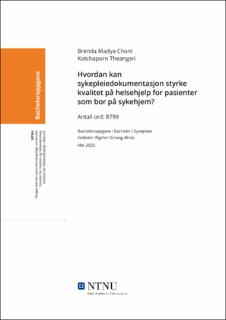| dc.contributor.advisor | Alnes, Rigmor Einang | |
| dc.contributor.author | Choni, Brenda Madya | |
| dc.contributor.author | | |
| dc.contributor.author | Theangsri, Kotchaporn | |
| dc.date.accessioned | 2020-08-16T16:04:33Z | |
| dc.date.available | 2020-08-16T16:04:33Z | |
| dc.date.issued | 2020 | |
| dc.identifier.uri | https://hdl.handle.net/11250/2672445 | |
| dc.description.abstract | Hensikt: Studiens hensikt er å utforske hvordan sykepleiedokumentasjon kan styrke kvalitet i helsehjelp som ytes til pasienter som bor på sykehjem.
Metode: Det systematiske litteratursøket resulterte i åtte forskningsartikler hvorav kvalitativ-, kvantitativ forskning, én med kombinert metode og én oversiktsstudie ble inkludert. Forskningsartikler, pensumlitteratur og selvvalgt litteratur er benyttet for å belyse problemstillingen.
Resultat: Utfordringer knyttet til dokumentasjonsarbeid på sykehjem er mangel på kultur, samt kunnskap om kvalitetsarbeid og dokumentasjon. Det er behov for tydelig struktur i dokumentasjon. Implementering av standard i dokumentasjon ved å integrere standardisert sykepleieplan og klassifikasjonssystem i de elektroniske pasientjournalsystemer kan mulig bedre fullstendigheten i dokumentasjon. Sykepleiers holdning påvirker også hvordan dokumentasjonsarbeid blir utført.
Konklusjon: Det kan være vanskelig å dokumentere om helsetilstander til eldre pasienter, særlig gjelder dette ved små endringer. For å kunne bedre dokumentasjonspraksis, er opplæring og implementering av standardisert dokumentasjon viktig. Ledelse spiller en avgjørende rolle i forbedringsarbeid. Sykepleier kan på sin side bidra til bedre dokumentasjonsrutiner på sykehjem ved å vise positiv holdning til kompetanseutvikling, samt ved å øke kunnskapsnivået blant medarbeidere og studenter gjennom undervisning og veiledning. Når utført sykepleiedokumentasjon er basert på kunnskap, vil det kunne bidra til å styrke kvaliteten i helsehjelpen. | |
| dc.description.abstract | Aim: The purpose of this study is to explore or find out how nursing documentation can enhance the quality of healthcare provided at nursing homes.
Method: A systematic literature search resulted in eight research articles of which, quality, quantitative research, one with combined method and one overview study were included. Research articles and literature from syllabus as well as self-selected literature have been used to illustrate the issue.
Result: Challenges associated with documentation in nursing homes are lack of culture of documentation as well as knowledge about quality of work and documentation. There is the need for unambiguous structure in documentation. To implement a standard of documentation by integrating standardized nursing plan and classification systems in the electronic patient journal systems, can improve the completeness and comprehensiveness of the documentation. The end documentation work is influenced by attitude of nurses.
Conclusion: It can be difficult to document the health standards of geriatric patients, especially when there are minimal changes. In other to change the nursing documentation practice for the better, training and implementation of a standardized nursing documentation is required. Leadership has an important role to play in quality improvement. Nurses on their part can contribute to better documentation routines in nursing homes by having positive attitude towards competence development as well as increasing competence level among colleagues/staff and students by way of teaching and guidance. When nursing documentation is done based on scientific methodologies it will in the end improve the quality in health care. | en |
| dc.publisher | NTNU | |
| dc.title | Hvordan kan sykepleiedokumentasjon styrke kvalitet på helsehjelp for pasienter som bor på sykehjem? | |
| dc.type | Bachelor thesis | |
